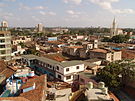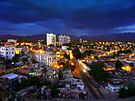- Demographics of Cuba
-
This article is about the demographic features of the population of Cuba, including population density, ethnicity, education level, health of the populace, economic status, religious affiliations and other aspects of the population.
The 2002 census figures supplied by the government claim that 65% of Cubans were light-skinned.
According to the 2002 census, Cuba's population was 11,177,743. The population of Cuba was 11,241,161 people on December 31, 2010.
Contents
Evolution of Cuba's population
Census history [1][2] Year Population 1774 171,600 1792 274,300 1817 572,363 1827 704,586 1833 730,000 1841 1,007,624 1861 1,396,530 1862 1,259,200 1877 1,509,291 1887 1,631,687 1899 1,572,797 1910 2,219,000 1920 2,997,000 1930 3,647,000 1950 5,516,000 1980 9,724,000 2000 11,142,000 2010 11,241,161 First Census was in 1774.
1899 Census taken by the U.S.Official 1775-1899 Cuba Census [3] White Non-white Census Number Percentage Number Percentage 1775 96,440 56.2 75,180 43.8 1792 153,559 56.4 118,741 43.6 1817 257,380 45.0 314,983 55.0 1827 311,051 44.2 393,435 55.8 1841 418,291 41.5 589,333 58.5 1861 793,484 56.8 603,046 43.2 1877 1,023,394 67.8 485,897 32.2 1887 1,102,889 67.6 528,798 32.4 1899 1,067,354 67.9 505,443 32.1 According to the Census, the Chinese were counted as white. Religion
Main article: Religion in CubaCuba has a multitude of faiths reflecting the island's diverse cultural elements. Catholicism, which was brought to the island by Spanish colonialists at the beginning of the 16th century, is the most prevalent professed faith. After the revolution, Cuba became an officially atheistic state and restricted religious practice. Since the Fourth Cuban Communist Party Congress in 1991, restrictions have been eased and, according to the National Catholic Observer, direct challenges by state institutions to the right to religion have all but disappeared,[4] though the church still faces restrictions of written and electronic communication, and can only accept donations from state-approved funding sources.[4] The Roman Catholic Church is made up of the Cuban Catholic Bishops' Conference (COCC), led by Jaime Lucas Ortega y Alamino, Cardinal Archbishop of Havana.[citation needed] It has eleven dioceses, 56 orders of nuns and 24 orders of priests. In January 1998, Pope John Paul II paid a historic visit to the island, invited by the Cuban government and Catholic Church.
Afro-Cuban religions, a blend of native African religions and Roman Catholicism, are widely practiced in Cuba. This diversity derives from West and Central Africans who were transported to Cuba, and in effect reinvented their African religions. They did so by combining them with elements of the Catholic belief system, with a result very similar to Brazil
Protestantism, introduced from the United States in the 18th century, has seen a steady increase in popularity. 300,000 Cubans belong to the island's 54 Protestant denominations. Pentecostalism has grown rapidly in recent years, and the Assemblies of God alone claims a membership of over 100,000 people. The Episcopal Church of Cuba claims 10,000 adherents. Cuba has small communities of Jews, Muslims, Buddhists and members of the Bahá'í
Cuban ancestry
Main article: Spanish immigration to CubaThe ancestry of Cubans comes from many sources:
During the 18th, 19th and early part of the 20th century, large waves of Spanish immigrants from Canary Islands, Catalonia, Andalusia, Galicia, and Asturias emigrated to Cuba. Between 1882 and 1898, a total of 508,455 people left Spain, and more than 750,000 Spanish immigrants left for Cuba between 1899 and 1923, with many returning to Spain.[5]
The Slave trade brought Africans to Cuba during its early history: Between 1842 and 1873, 221,000 African slaves entered Cuba.[5]
Other European people that have contributed include:
 French
French Portuguese
Portuguese Italians
Italians Germans
Germans Russians
Russians
People from Asia:
Between 1842 and 1873, 124,800 Chinese arrived.[5]
There is also a small number of Jews living in Cuba.
Genetics
A 1995 study done on the population of Pinar del Rio, found that 50% of the Mt-DNA lineages (female lineages) could be traced back to Europeans, 46% to Africans and 4% to Native Americans. This figure is consistent with both the historical background of the region, and the current demographics of it.[6]
According to another study in 2008, the geographical origin attributed to each mtDNA haplogroup, 45% of the sequences found in Cubans are of African origin, 33% of Native American origin and 22% of West Eurasian origin (namely, Europe and the Middle East)[7].
Regarding Y-chromosome haplogroups (male lineages), 78.8% of the sequences found in Cubans are of West Eurasian origin, 19.7% of African origin and 1.5% of East Asian origin. Among the West Eurasian fraction, the vast majority of individuals belong to West European haplogroup R1b. The African lineages found in Cubans have a Western (haplogroups E1, E2, E1b1a ) and Northern (E1b1b-M81 ) African origin. The "Berber" haplogroup E1b1b1b (E-M81), is found at a frequency of 6.1%.[8]
According to Fregel et al. (2009), the fact that autochthonous male North African E-M81 and female U6 lineages from the Canaries have been detected in Cuba and Iberoamerica, demonstrates that Canary Islanders with indigenous ancestors actively participated in the American colonization.[9]
Origins of Cuban Spanish
Of all the regional variations of the Spanish language, traditional Cuban Spanish is most similar to, and originates largely from the Spanish spoken in the Canary Islands. Cuba owes much of their speech patterns to the Canarian migration, which in the 19th and early 20th century was heavy and continuous. There was also migrations of Galicians and Asturians as well, but they did not leave a mirror image on their accent on the Cuban accent like the Canarian people did. Much of the typical Cuban replacements for standard Spanish vocabulary stems from Canarian lexicon. For example, guagua (bus) differs from standard Spanish autobús the former originated in the Canaries and is an onomatopoeia stemming from the sound of a Klaxon horn (wah-wah!). An example of Canarian usage for a Spanish word is the verb fajarse [10] ("to fight"). In standard Spanish the verb would be pelearse, while fajar exists as a non-reflexive verb related to the hemming of a skirt.
Demographic statistics from the Official 2002 Cuba Census

Life in CubaArt
Cinema
Cuisine
Culture
Demographics
Education
Health
Holidays
Human Rights
Literature
Music
Politics
Religion
TourismPopulation 11,177,743 Age structure - 0-14 years: 19.1% (male 1,117,677/female 1,058,512)
- 15-64 years: 70.3% (male 4,001,161/female 3,999,303)
- 65 years and over: 10.6% (male 554,148/female 652,019) (2006 est.)
Median age Total: 35.9 years - Male: 35.2 years
- Female: 36.5 years (2006 est.)
Population growth rate -0.01% (2006 est.) Birth rate 11.89 births/1,000 population (2006 est.) Death rate 7.22 deaths/1,000 population (2006 est.) Net migration rate Sex ratio - At birth: 1.06 male(s)/female
- Under 15 years: 1.06 male(s)/female
- 15-64 years: 1 male(s)/female
- 65 years and over: 0.85 male(s)/female
- Total population: 0.99 male(s)/female (2006 est.)
Infant mortality rate Total: 6.32 deaths/1,000 live births - Male: 6.99 deaths/1,000 live births
- Female: 5.41 deaths/1,000 live births (2006 est.)
Life expectancy at birth Total population: 77.41 years - Male: 75.11 years
- Female: 79.85 years (2006 est.)
Total fertility rate 1.66 children born/woman (2006 est.) HIV/AIDS - Adult prevalence rate: less than 0.1% (2003 est.)
- People living with HIV/AIDS: 3,300 (2003 est.)
- Deaths: less than 200 (2003 est.)
Ethnic groups - Whites: 65.05%
- Blacks: 10.08%
- Mulattoes: 23.84%
- Asians: 1.02%
Religions Nominally 85% Roman Catholic prior to the Revolution; Protestants, Jehovah's Witnesses, Muslims, Jews, and Santeria are also represented. Languages - Spanish
- English
- Haitian Creole
Literacy Total population: 99.8% (2002 census) - Male: 99.8%
- Female: 99.8%
Definition: age 15 and over can read and write
Illicit migration is a continuing problem. Cubans require Cuban government documentation to leave, and this is commonly refused. Cubans attempt to depart the island and enter the US using homemade rafts, alien smugglers, direct flights, or falsified visas; Cubans also use non-maritime routes to enter the US including direct flights to Miami and overland via the southwest US/Mexican border, and islands adjacent to Puerto Rico and the US Virgin Islands.
Cuban census 2002
The 2002 census is the most recent official census of Cuba (as of 2011).
Population by region
Population and Area by region Province Area (km²) Area (%) Population Population (%) Density Cuba Total 109,886.19 100 11,177,743 100 101.72 Pinar del Río 10,904.03 9.92 726,574 6.50 66.63 La Habana 5,791.59 5.22 711,066 6.36 124.06 Ciudad de la Habana 721.01 0.66 2,201,610 19.70 3053.49 Matanzas 11,802.72 10.74 670,427 6.00 56.80 Villa Clara 8,412.41 7.06 817,395 7.31 97.17 Cienfuegos 4,180.02 3.80 395,183 3.54 94.54 Sancti Spíritus 6,736.51 6.13 460,328 4.12 68.33 Ciego de Ávila 6,783.13 6.17 411,766 3.68 60.70 Camagüey 15,615.02 14.21 784,178 7.02 50.22 Las Tunas 6,587.75 6.00 525,485 4.70 79.77 Holguín 9,292.83 8.46 1,021,321 9.14 109.90 Granma 8,375.49 7.62 822,452 7.36 98,20 Santiago de Cuba 6,156.44 5.60 1,036,281 9.27 168.32 Guantánamo 6,167.97 5.61 507,118 4.54 82.22 Isla de la Juventud 2,419.27 2.20 86,559 0.77 35.78 Largest cities
Rank City Name Province Pop. 
Havana
1 Havana Havana 2,201,610 
Camagüey
2 Santiago de Cuba Santiago de Cuba 423,392 3 Camagüey Camagüey 301,574 4 Holguín Holguín 269,618 5 Santa Clara Villa Clara 210,220 6 Guantánamo Guantánamo 208,145 7 Bayamo Granma 144,664 8 Victoria de Las Tunas Las Tunas 143,582 9 Cienfuegos Cienfuegos 140,734 10 Manzanillo Granma 132,789 See also
- Cuban American
- Spanish people
- Canarian people
- Catalan people
- Chinese Cuban
- Afro-Cuban
- Isleños
- Jewish Cuban
- Women in Cuba
- Ranked list of Cuban provinces
References
- ^ The 1899 Official Census. Page 72.
- ^ CUBA: population growth of the whole country
- ^ The 1899 Cuba Census. See Page 97.
- ^ a b Catholic church in Cuba strives to reestablish the faith National Catholic Observer
- ^ a b c La inmigración entre 1902 y 1920
- ^ Torroni, Antonio; Brown, Michael D.; Lott, Marie T.; Newman, Nancy J.; Wallace, Douglas C. (1995). "African, Native American, and European mitochondrial DNAs in Cubans from Pinar del Rio Province and implications for the recent epidemic neuropathy in Cuba". Human Mutation 5 (4): 310–7. doi:10.1002/humu.1380050407. PMID 7627185.
- ^ Mendizabal, Isabel; Sandoval, Karla; Berniell-Lee, Gemma; Calafell, Francesc; Salas, Antonio; Martinez-Fuentes, Antonio; Comas, David (2008). "Genetic origin, admixture, and asymmetry in maternal and paternal human lineages in Cuba". BMC Evolutionary Biology 8: 213. doi:10.1186/1471-2148-8-213. PMC 2492877. PMID 18644108. http://www.pubmedcentral.nih.gov/articlerender.fcgi?tool=pmcentrez&artid=2492877.
- ^ Y-chromosome haplogroup frequencies found in Cuba (132 individuals) grouped according to their phylogeographic origin, Mendizabal et al. (2008)
- ^ Rosa Fregel, Verónica Gomes, Leonor Gusmão, Ana M González , Vicente M Cabrera1 , António Amorim, Jose M Larruga et al. (2009) Demographic history of Canary Islands male gene-pool: replacement of native lineages by European BMC Evolutionary Biology 2009, 9:181doi:10.1186/1471-2148-9-181
- ^ fajar at Diccionario de la Real Academia Española.
- ^ CIA - The World Factbook - Cuba
 This article incorporates public domain material from the CIA World Factbook document "2006 edition".
This article incorporates public domain material from the CIA World Factbook document "2006 edition".
- Statoids (July 2003). "Municipios of Cuba". http://www.statoids.com/ycu.html. Retrieved 2007-02-15.
- Matanzas Portal (2004). "Population gowth by municipality and province". Archived from the original on 2007-02-15. http://web.archive.org/web/20070215082736/http://www.atenas.inf.cu/todo/Estadisticas/TABLA+No_3balance.htm. Retrieved 2007-02-21.
- The Peninsular (May 2007). Population, birth rate falling in Cuba: Official
External links
Demographics of North America Sovereign states Dependencies and
other territories- Anguilla
- Aruba
- Bermuda
- Bonaire
- British Virgin Islands
- Cayman Islands
- Curaçao
- Greenland
- Guadeloupe
- Martinique
- Montserrat
- Puerto Rico
- Saint Barthélemy
- Saint Martin
- Saint Pierre and Miquelon
- Saba
- Sint Eustatius
- Sint Maarten
- Turks and Caicos Islands
- United States Virgin Islands
Categories:- Cuban society
- Demographics by country
Wikimedia Foundation. 2010.


